CHEVROLET CAVALIER 1993 1.G Repair Manual
Manufacturer: CHEVROLET, Model Year: 1993, Model line: CAVALIER, Model: CHEVROLET CAVALIER 1993 1.GPages: 308, PDF Size: 15.62 MB
Page 61 of 308
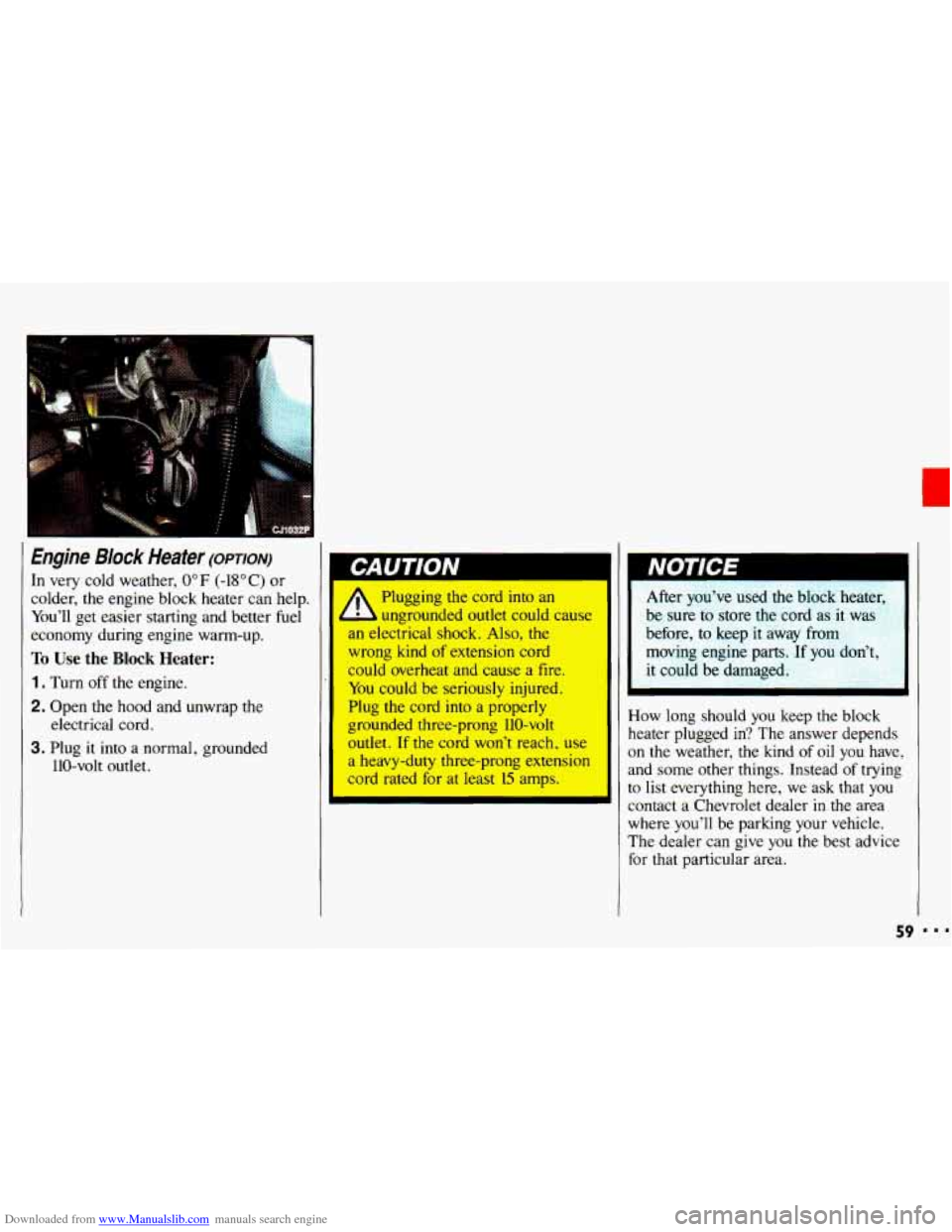
Downloaded from www.Manualslib.com manuals search engine Engine Block Heater (OPTION)
In very cold weather, 0°F (-18°C) or
colder, the engine block heater can help.
You’ll get easier starting and better fuel
economy during engine warm-up.
To Use the Block Heater:
1. Turn off the engine.
2. Open the hood and unwrap the
3. Plug it into a normal, grounded
electrical cord.
110-volt
outlet.
A
Plugging the cord into an
ungrounded outlet could cause
an electrical shock. Also, the
wrong kind
of extension cord
could overheat and cause a
fire.
You could be seriously injured.
Plug the cord into a properly
grounded three-prong 110-volt
outlet.
If the cord won’t reach, use
a heavy-duty three-prong extension
cord rated for at least
15 amps. After
you’ve
used the bfock hea,,,
be sure to store the cord as it was
before, to keep it away from
moving engine parts. If
you don’t,
it could be damaged.
How long should
you keep the block
heater plugged in? The answer depends
on the weather, the
kind of oil you have,
and some other things. Instead of trying
to list everything here,
we ask that you
contact a Chevrolet dealer
in the area
where you’ll be parking
your vehicle.
The dealer can give
you the best advice
for that particular area.
59 I..
Page 62 of 308
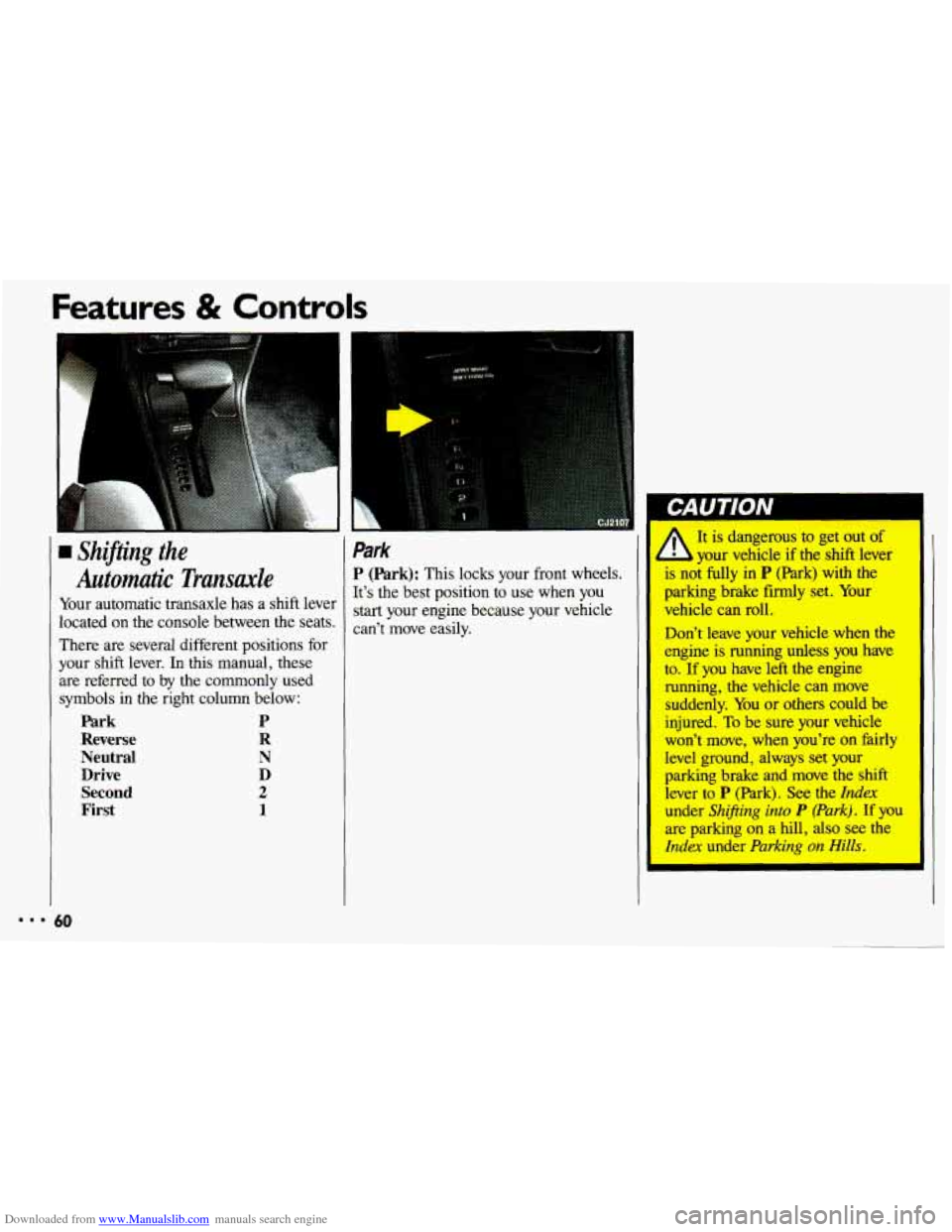
Downloaded from www.Manualslib.com manuals search engine Features & Controls
rn Shifting the
Automatic Transaxle
Your automatic transaxle has a shift lever
located
on the console between the seats.
There are several different positions for
your shift lever. In this manual, these
are referred to by the commonly used
symbols in
the right column below:
Park P
Reverse R
Neutral
N
Drive D
Second
2
First 1
Park
P (Park): This locks your front wheels.
It’s the best position to use when you
start your engine because your vehicle
can’t move easily.
I It is dangerous to get out of
your vehicle if the shift lever
is noi fully in
P (Park) with the
parking brake firmly set. Your
vehicle can roll.
Don’t leave your vehicle when the
engine is running unless
you have
to.
If you have left the engine
running, the vehicle can move
suddenly. You or others could be
injured.
To be sure your vehicle
won’t move, when you’re on fairly
level ground, always set your
parking brake and move the shift
lever to
P (Park). See the Index
under Shifting into P (Park). If you
are parking on a hill, also see the
Index under Parking on Hills.
Page 63 of 308
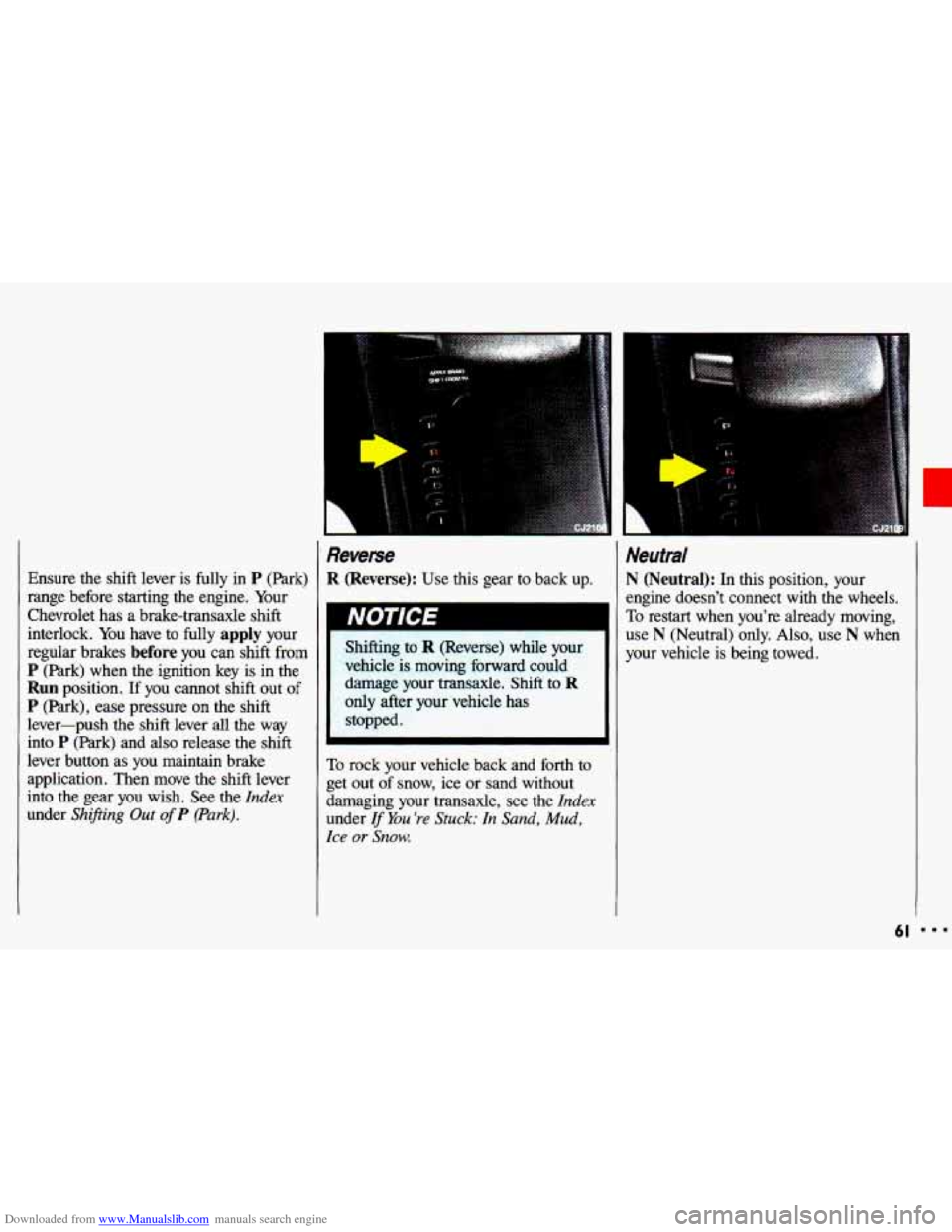
Downloaded from www.Manualslib.com manuals search engine Ensure the shift lever is fully in P (Park)
range before starting the engine. Your
Chevrolet has a brake-transaxle shift
interlock. You have to fully
apply your
regular brakes
before you can shift fiom
P (Park) when the ignition key is in the
Run position. If you cannot shift out of
P (Park), ease pressure on the shift
lever-push the shift lever
all the way
into
P (Park) and also release the shift
lever button as you maintain brake
application. Then move the shift lever
into
the gear you wish. See the Index
under Shifting Out of P (Park),
U
Reverse
R (Reverse): Use this gear to back up.
Shifting to
R (Reverse) while your
vehicle
is moving forward could
damage your transaxle. Shift
to R
only after your vehicle has
Stopped-
Neutmi
N (Neutral): In this position, your
engine doesn’t connect with the wheels.
To restart when you’re already moving,
use
N (Neutral) only. Also, use N when
your vehicle
is being towed.
To rock your vehicle back and forth to
get out of snow, ice or sand without
damaging your transaxle, see the
Index
under If You ’re Stuck: In Sand, Mud,
Ice or Snow.
61
Page 64 of 308
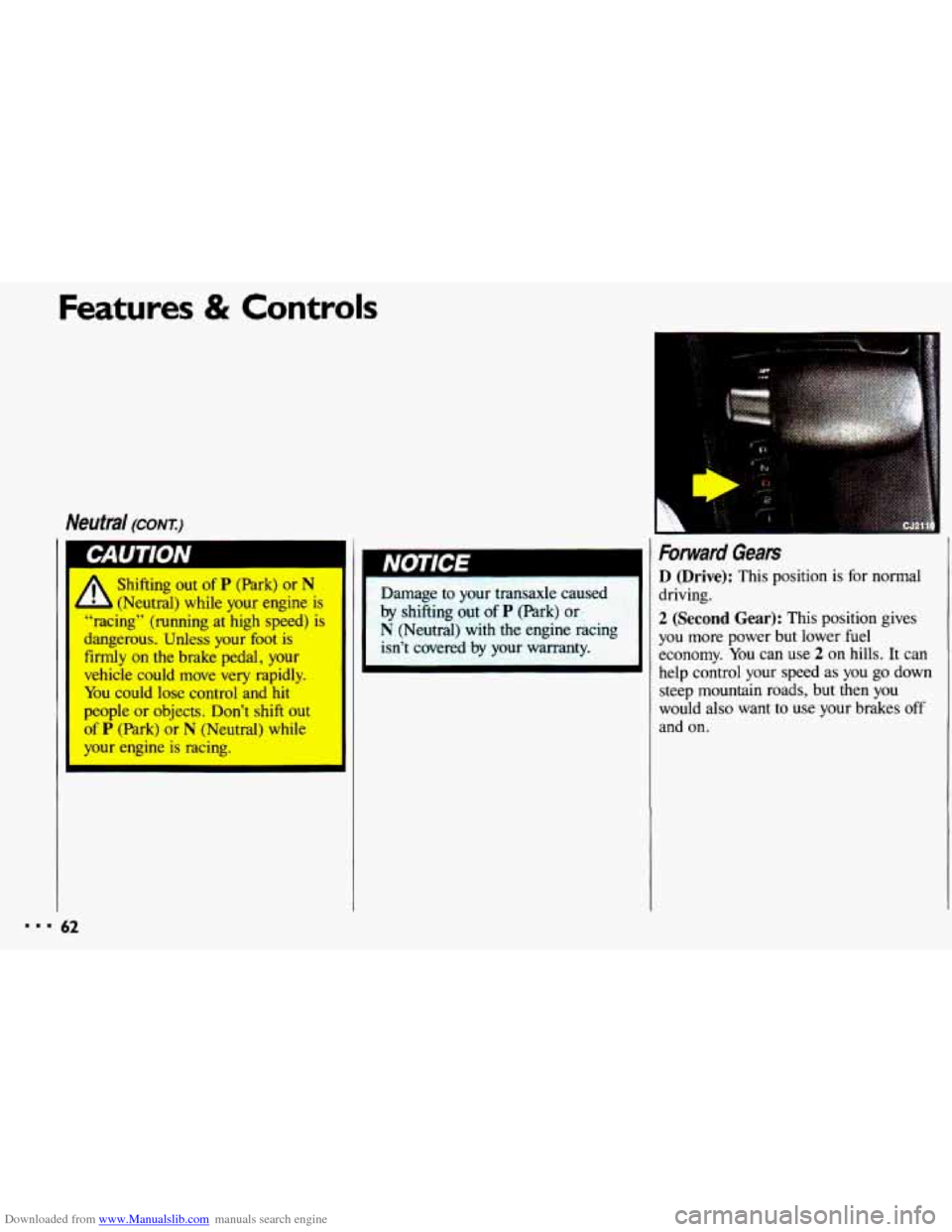
Downloaded from www.Manualslib.com manuals search engine Features & Controls
Neutral (CONT:)
Shifting out of P (Park) or N
(Neutral) while your engine is
--racing” (running at high speed) is
dangerous. Unless your foot is
firmly on the brake pedal, your
vehicle could
move very rapidly.
You could lose control and hit
people or objects. Don’t shift out
of
P (Park) or N (Neutral) while
your engine is racing.
62
Damage to your transaxle caused
by shifting
out of P (Park) or $i;$JJ
N (Neutral) with the engine racing
isn’t covered
by your warranty.
Forward Gears
D (Drive): This position is for normal
driving.
2 (Second Gear): This position gives
you
more power but lower fuel
economy. You can
use 2 on hills. It can
help control your speed
as you go down
steep mountain roads, but then you
would also want to
use your brakes off
and on.
Page 65 of 308
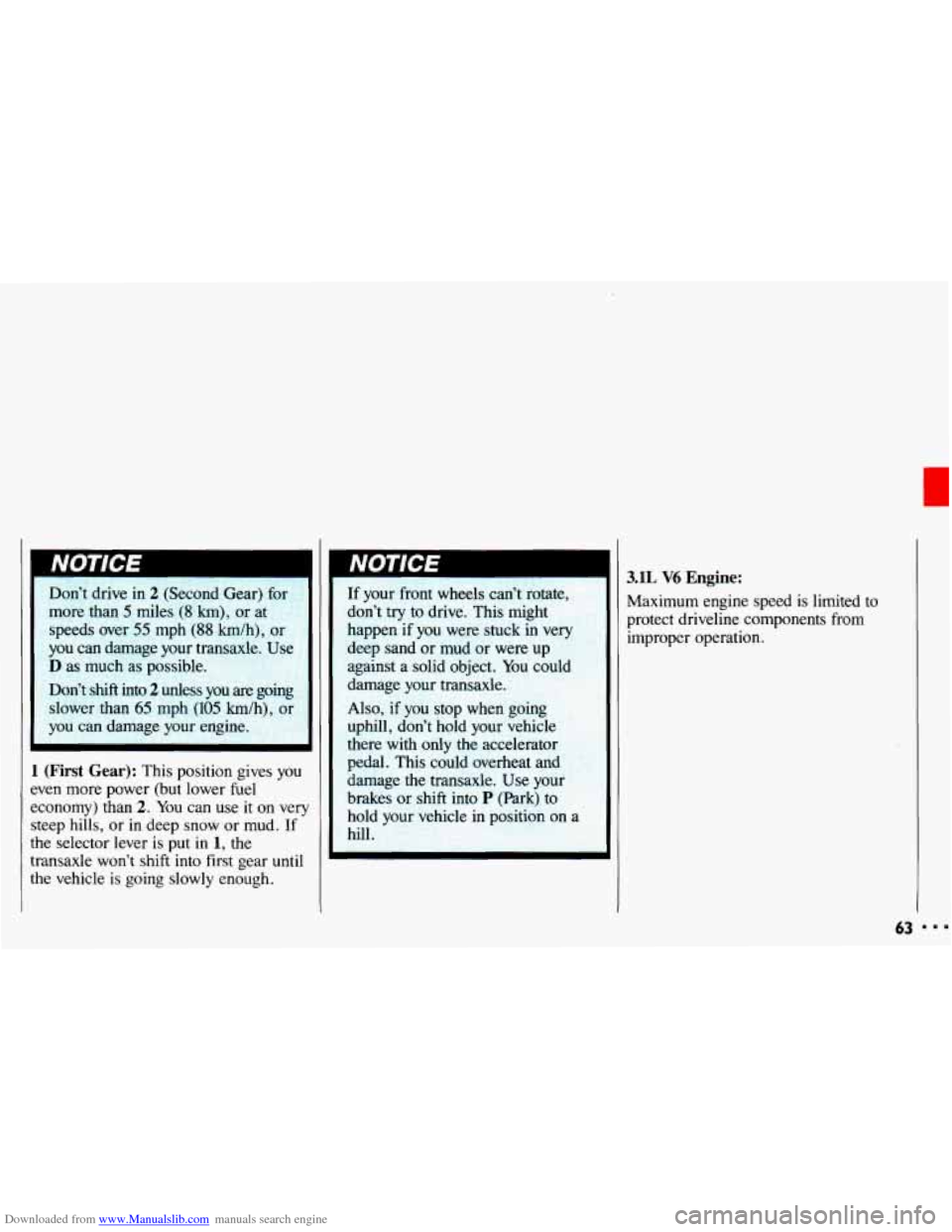
Downloaded from www.Manualslib.com manuals search engine Don’t drive in 2 (Second Gear) fo
more than 5 miles (8 km), or at
speeds over
55 mph (88 km/h), or
you can damage your transaxle. U!
D as much as possible.
Don’t
shift into 2 unless you are going
slower than
65 mph (105 km/h),
you can damage your engine.
r I
1 (First Gear): This position gives you
even more power (but lower fuel II
If your front wheels can’t rotate,
don’t try to drive. This might
happen if
you were stuck in very
deep sand or mud or were up
against a solid object.
aula
damage your transal-’
Also, if you stop when going
uphill, don’t hold your vehicle
there with only
the accelerator
-
pedal. This cduld overheat and
damage the transaxle.
Use your
brakes or shift into
P (Park) to
hold lr vehicle
in position on a
hill.
economy)
than 2. You can use it crh very
steep hills, or in deep snow or mud. If
the selector lever is put in 1, the
transaxle won’t shift
into first gear until
the vehicle is going slowly enough.
3.lL V6 Engine:
Maximum engine speed is limited to
protect driveline components from
improper operation.
Page 66 of 308
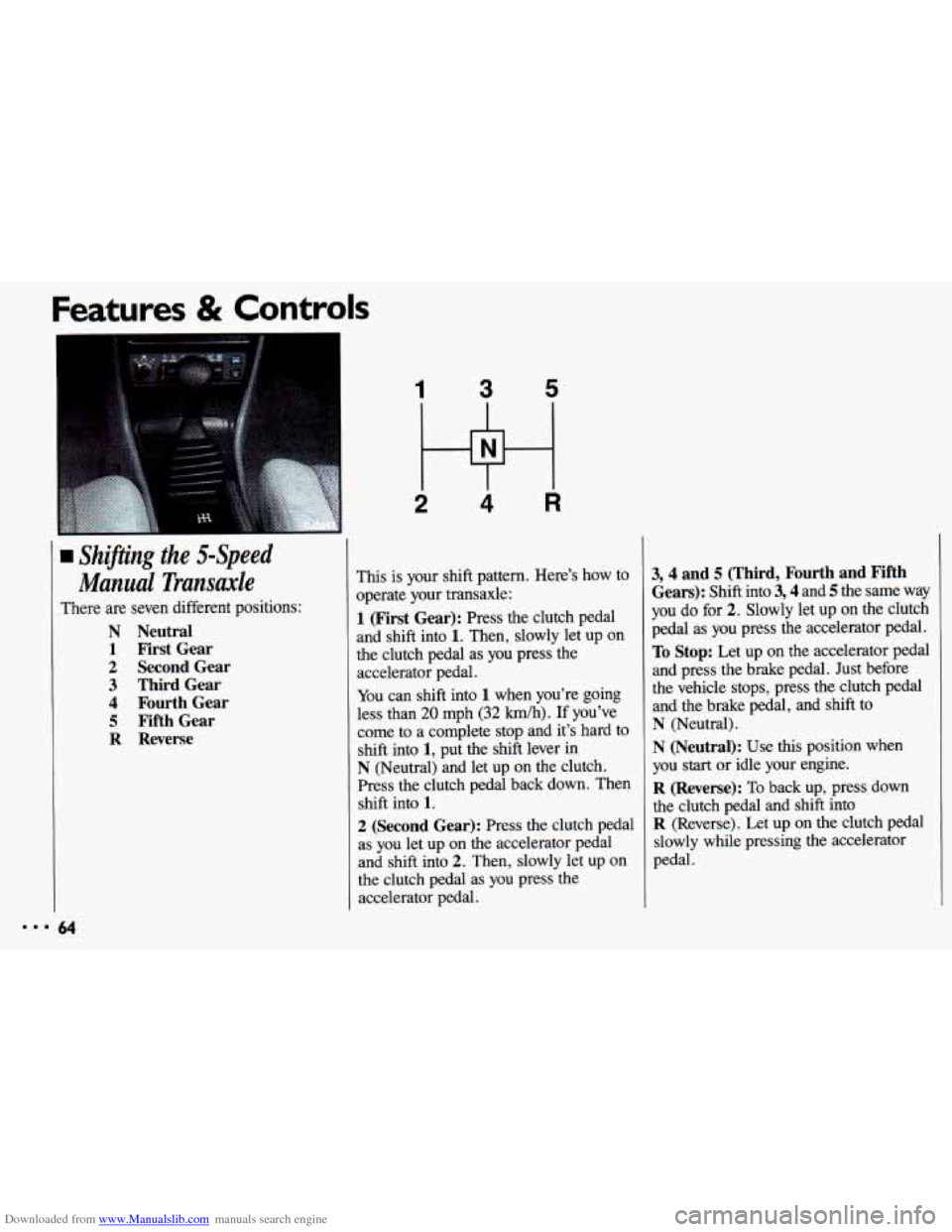
Downloaded from www.Manualslib.com manuals search engine Features & Controls
1 Shifting the 5-Speed
Manual Transude
There are seven different positions:
N Neutral
1 First Gear
2 Second Gear
3 Third Gear
4 Fourth Gear
5 Fifth Gear
R Reverse
1 3 5
2 Hi 4 R
This is your shift pattern. Here’s how to
operate your transaxle:
1 (First Gear): Press the clutch pedal
and shift into
1. Then, slowly let up on
the clutch pedal as you press the
accelerator pedal.
You can shift into 1 when you’re going
less than
20 mph (32 km/h). If you’ve
come to a complete stop and it’s hard to
shift into
1, put the shift lever in
N (Neutral) and let up on the clutch.
Press the clutch pedal back down. Then
shift into
1.
2 (Second Gear): Press the clutch pedal
as you let up on the accelerator pedal
and shift into
2. Then, slowly let up on
the clutch pedal as you press the
accelerator pedal.
3,4 and 5 (Third, Fourth and Fifth
Gears):
Shift into 3,4 and 5 the same way
you do for
2. Slowly let up on the clutch
pedal as you press the accelerator pedal.
To Stop: Let up on the accelerator pedal
and press the brake pedal. Just before
the vehicle stops, press the clutch pedal
and the brake pedal, and shift to
N (Neutral).
N (Neutral): Use this position when
you
start or idle your engine.
R (Reverse): To back up, press down
the clutch pedal and shift into
R (Reverse). Let up on the clutch pedal
slowly while pressing the accelerator
pedal.
Page 67 of 308
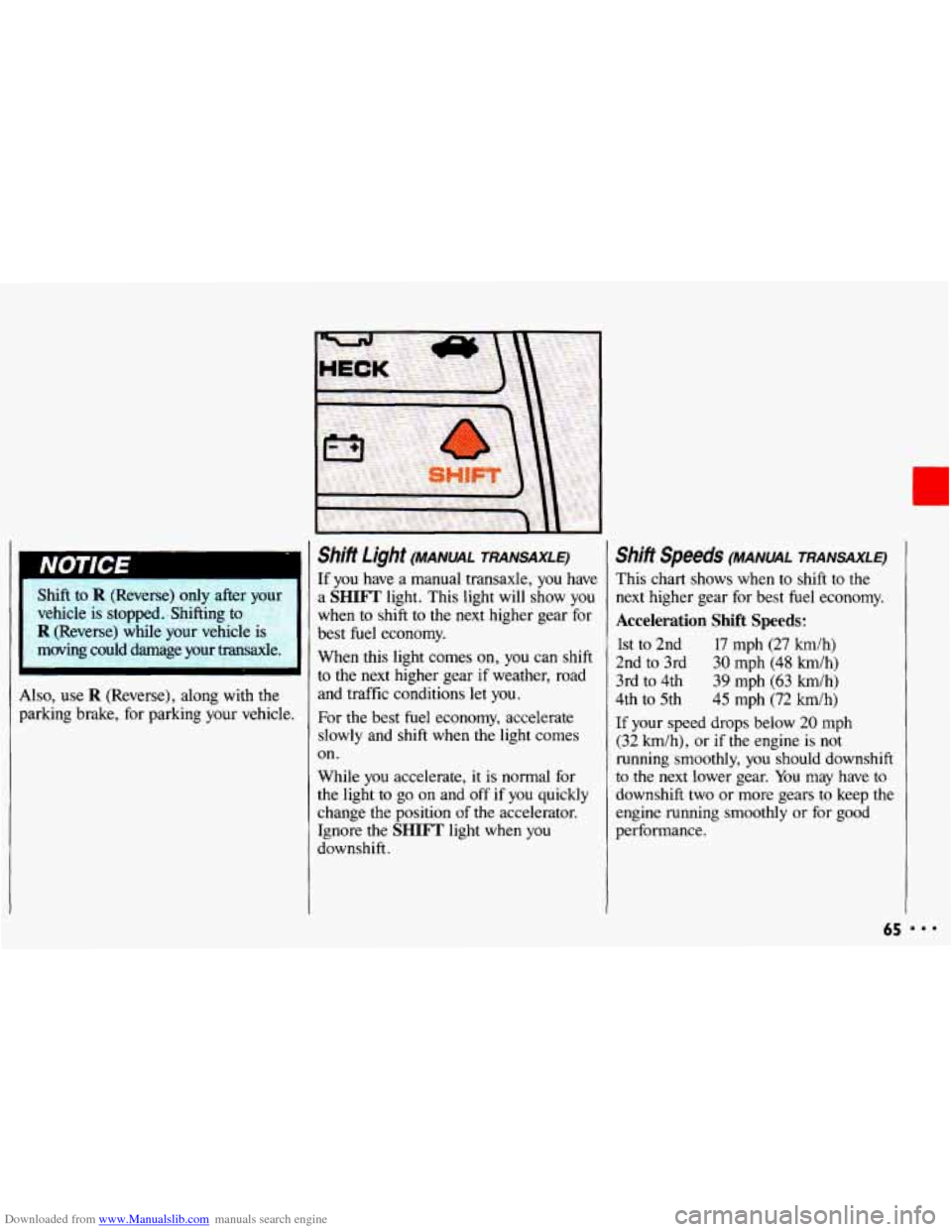
Downloaded from www.Manualslib.com manuals search engine r
Shift to R (Reverse) only afte
vehicle is stopped. Shifting to
R (Reverse) while your vehicle is
moving could damage your transaxle.
Also, use
R (Reverse), along with the
parking brake,
for parking your vehicle.
Shift Light (MANUAL TRANSAXLE)
If you have a manual transaxle, you have
a
SHIFT light. This light will show you
when to shift to the next higher gear for
best fuel economy.
When this light comes
on, you can shift
to the next higher gear if weather, road
and traffic conditions let you.
For
the best fuel economy, accelerate
slowly and shift when the light comes
on.
While you accelerate,
it is normal for
the light
to go on and off if you quickly
change the position
of the accelerator.
Ignore the
SHIFT light when you
downshift.
Shifi Speeds (MANUAL TRANSAXLE)
This chart shows when to shift to the
next higher gear for best fuel economy.
Acceleration Shift Speeds:
1st to 2nd 17 mph (27 km/h)
2nd to 3rd
30 mph (48 km/h)
3rd to 4th 39 mph
(63 h/h)
4th
to 5th 45 mph (72 h/h)
If your speed drops below 20 mph
(32 h/h), or if the engine is not
running smoothly,
you should downshift
to the
next lower gear. You may have to
downshift
two or more gears to keep the
engine running smoothly or
for good
performance.
65
Page 68 of 308
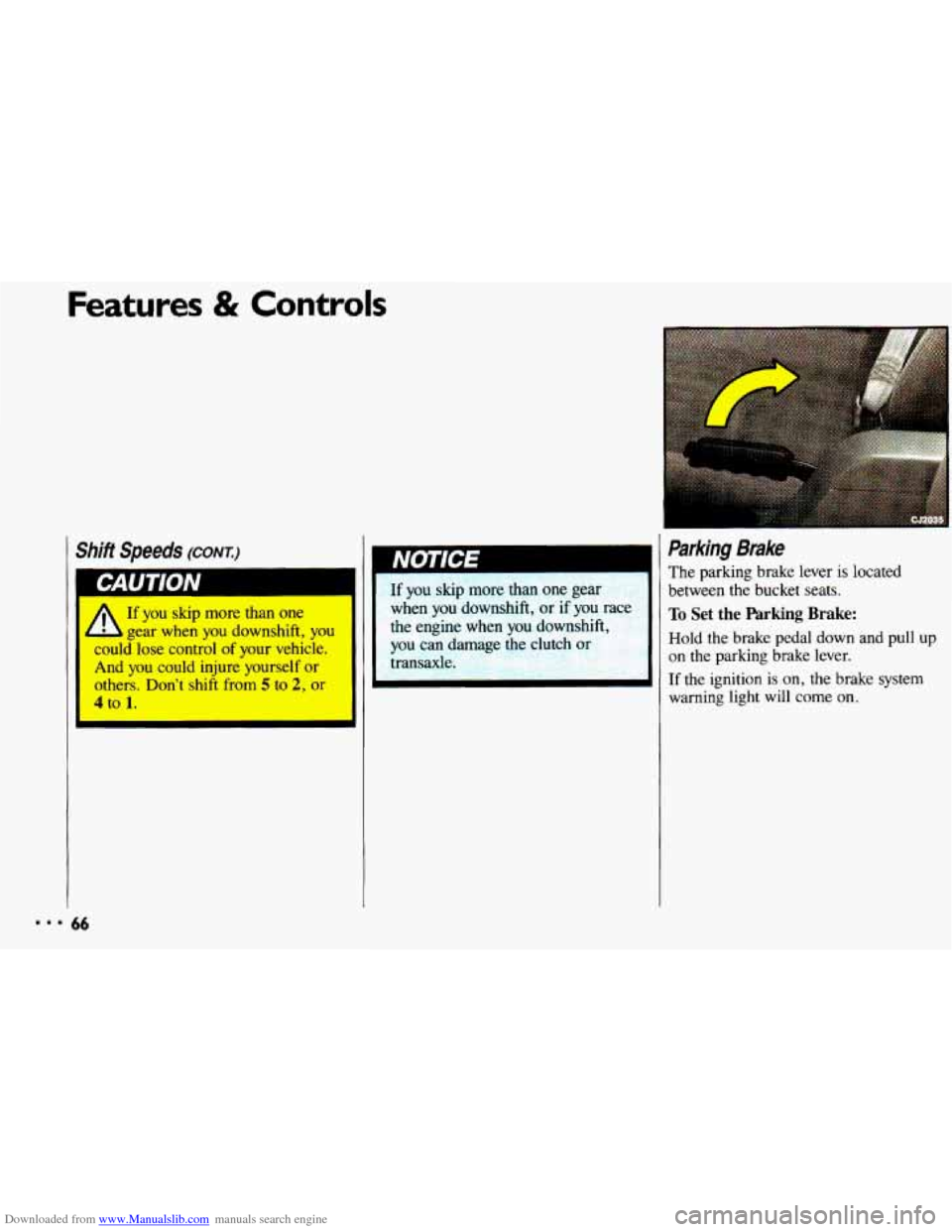
Downloaded from www.Manualslib.com manuals search engine Features & Controls
ShiiT Speeds (COPIT.)
If you skip more than one
4 1 gear when you downshift, you
could lose control of your vehicle.
And you could injure yourself
or
others. Don’t shift from 5 to 2, or
4 to 1.
I
I b
66
when you downshift, or if you
the engine when you downshift,
you
can damage the clutch or
transaxle.
i
Parking Brake
The parking brake lever is located
between
the bucket seats.
To Set the Parking Brake:
Hold the brake pedal down and pull up
on the parking brake lever.
If the ignition is on, the brake system
warning
light will come on.
Page 69 of 308
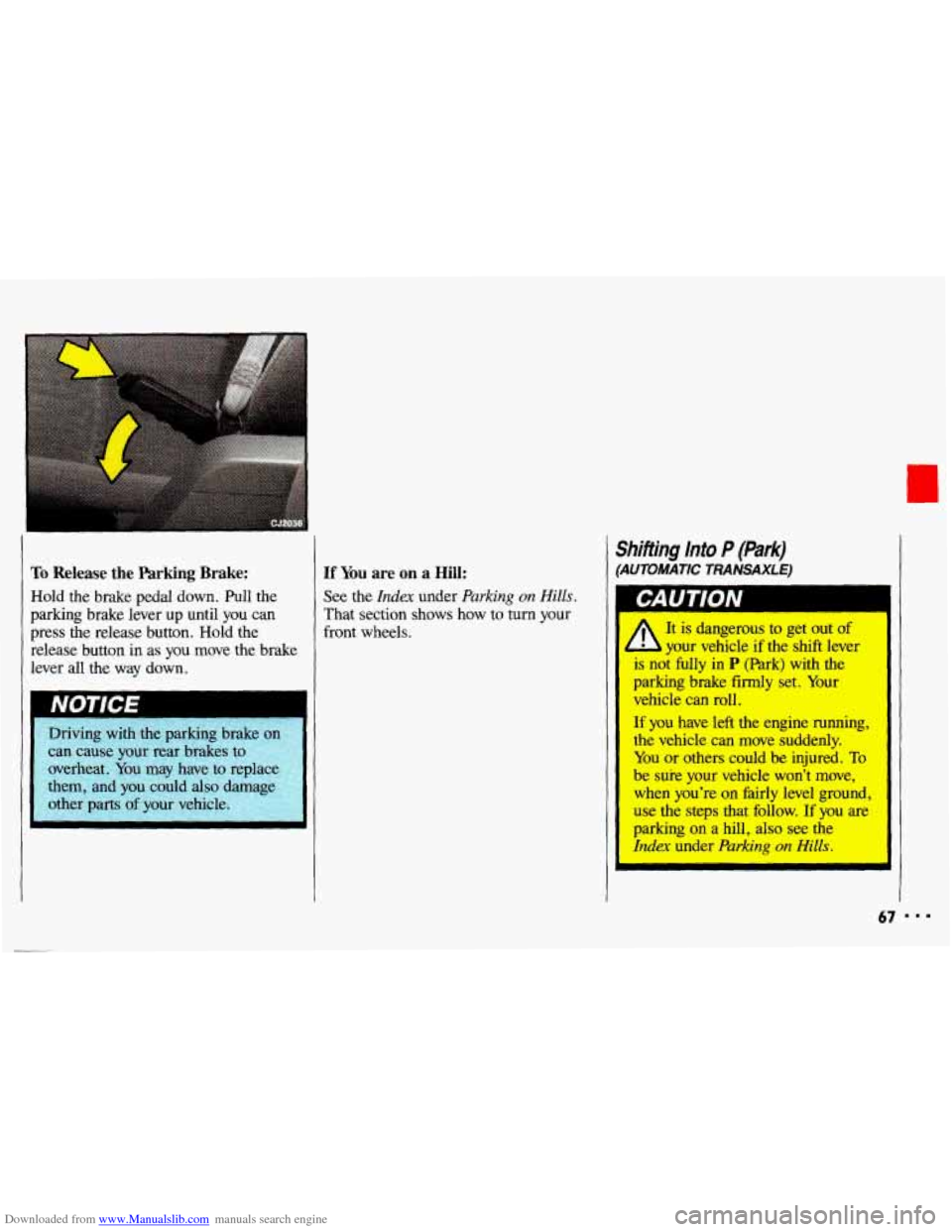
Downloaded from www.Manualslib.com manuals search engine To Release the Parking Brake:
Hold the brake pedal down. Pull the
parking brake lever up until you can
press the release button. Hold the
release button in as you move the brake
lever all the way down.
Driving with the parking brake on
I
can cause your rear brakes to
overheat.
You may have to replam
them, and
you could also dama
other parts
of your vehicle.
J
If You are on a Hill:
See the Index under Parking on Hills.
That section shows how to turn your
front wheels.
Shifting Into P (Park)
(AUTOMATIC TRANSAXLE)
A
It is dangerous to get out of
your vehicle if the shift lever
is not fully in
P (Park) with the
parking brake firmly set. Your
vehicle can roll.
If you have left the engine running,
the vehicle can move suddenly.
You or others could be injured. To
be sure your vehicle won’t move,
when you’re on fairly level ground,
use the steps that follow.
If you are
parking on a hill, also
see the
Index under Parking on Hills.
67
Page 70 of 308
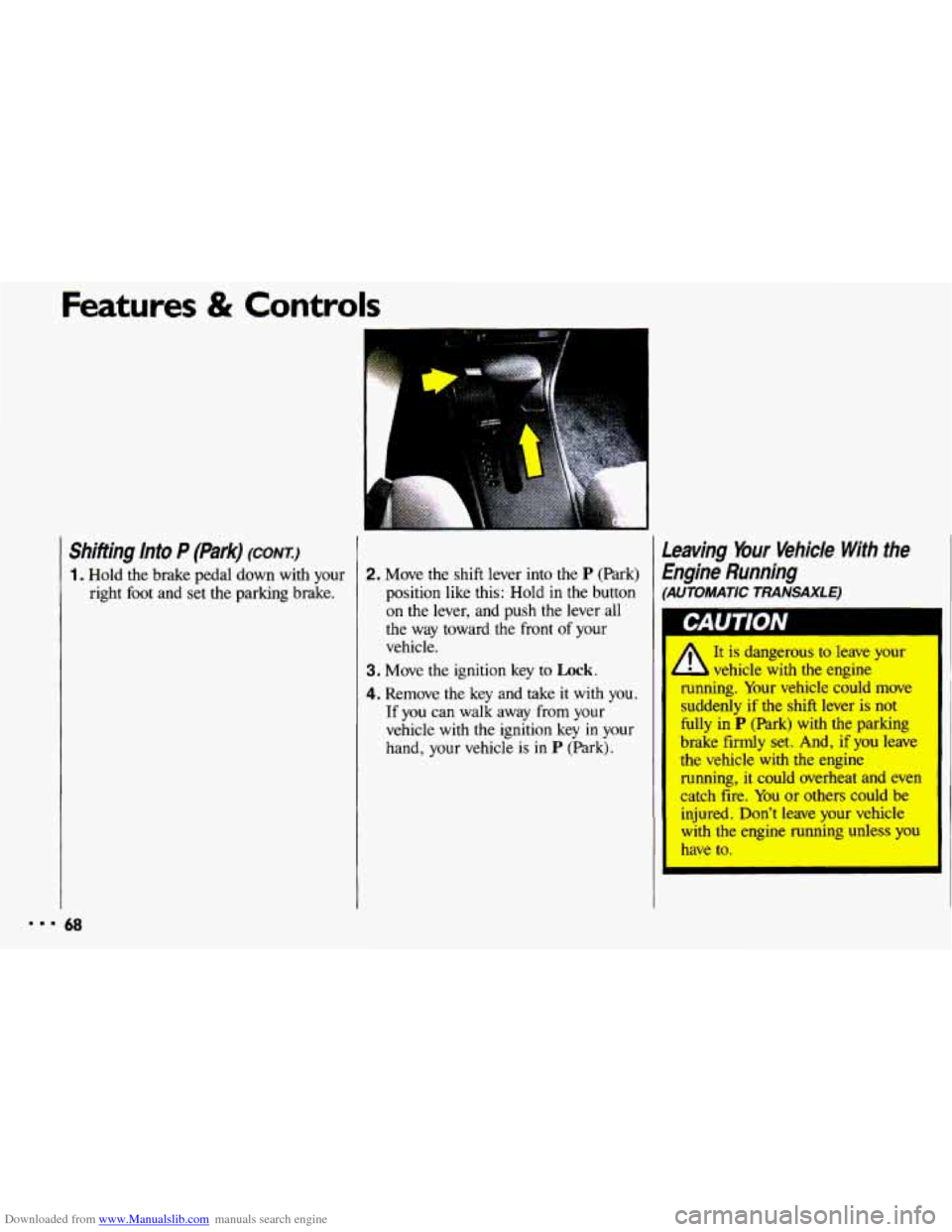
Downloaded from www.Manualslib.com manuals search engine Features & Controls
Shifting Into P (Park) (CONTI
1. Hold the brake pedal down with your right foot and set the parking brake.
A
2. Move the shift lever into the P (Park)
position like this: Hold in the button on the lever, and push the lever all
the way toward the front of your
vehicle.
3. Move the ignition key to Lock.
4. Remove the key and take it with you.
If you can walk away
from your
vehicle with the ignition key
in your
hand, your vehicle is in
P (Park).
Leaving Your Vehicle With the
Engine Running
(AUTOMATIC TRANSAXLE)
It is dangerous to leave your
running. Your vehicle could move
suddenly
if the shift lever is not
fully in
P (Park) with the parking
brake
firmly set. And, if you leave
the vehicle
with the engine
running, it could overheat and even
catch fire. You
or others could be
injured. Don't leave your vehicle
with the engine running unless you
have to.
I I L vehicle with the engine